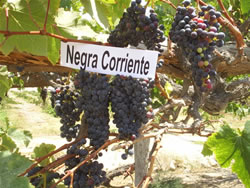Pisco has been produced in the department of Tacna since colonial times. The production of the Negra Criolla grape variety (Vitis vinifera L.), cultivated in the Locumba-Cinto, Magollo, Pocollay, Calana, and Pachia zones, with grape plantations in Los Palos, is dedicated to the production of wines and Piscos. The area’s climate factors, the soil and cultural and agricultural practices generate an ideal ecosystem for the production of this grape variety and its industrialization.
The name Tacna comes from the Quechua word takana, “I hit.” Its geographical coordinates situate the region between latitudes 16°58’ to 18°20’ and longitudes 69°28’ to 71°02.’ It is bordered on the northeast by the region of Moquegua, to the north by the department of Puno, to the east the Republic of Bolivia, to the south, the Republic of Chile and to the west by the coastline of the Pacific Ocean. Two-thirds part of the territory corresponds to coastal
 areas, and one third is situated along the mountains. The coast has a dry climate, with temperatures varying between 12º to 30ºC, and four coastal rivers condition the formation of three isolated valleys. The average temperature is 17.5 °C.
areas, and one third is situated along the mountains. The coast has a dry climate, with temperatures varying between 12º to 30ºC, and four coastal rivers condition the formation of three isolated valleys. The average temperature is 17.5 °C. Within the vineyards and the production fields of the Tacna region the Italia and Negra Criolla grape varieties predominate as the raw materials for the production of wines and Pisco which are distributed in five districts of the Province of Tacna, and one in the Province of Jorge Basadre Grohoman.
PROVINCE DISTRICT ZONE OF PRODUCTION VALLEY
Tacna Tacna Magollo Tacna
Tacna Pachía Pachía Tacna
Tacna Calana Calana Tacna
Tacna Pocollay Pocollay Tacna
Tacna Inclán Puquio Sama
J. Basadre Locumba Locumba Locumba
Tacna is the fourth best producer of grapes at the national level, with about 500 hectares of vineyards and a production of 10,810 kilograms per hectare. Tacna’s bodegas produce about 108,000 liters of Pisco, the rest are allocated to the production of wine, and the marketing of table grapes (Source: Ministry of Production of Tacna, 2008).
“Tacna Pisco is transparent, clean and clear; without color. If the Pisco is made from Negra Criolla grapes, the aromas of the raw materials from which the grapes come must not be dominating and one should perceive pleasant herbaceous smells, it is moderate and persistant.” (---According to a sensory analytical study “Determination of the Negra Criolla (Vitis vinifera L.) Grape Pisco Sensory Profile through quantitative descriptive analysis in the Tacna Region”--Linares, 2011).
Pisco made from the Negra Criolla grape in regards to the aroma is slightly alcoholic, with smells of dried fruit and wood, a slight smell of syrup, vanilla and citrus fruits. Light notes of herbs and white flowers. In regards to taste, it is alcoholic, slightly astringent, sweet and bitter, with a presence of dried fruit, wood, vanilla and herbs. It is a persistent Pisco with character.
By Engineer Patricia Linares
Enologist and Pisco Taster
Translated by Katrina Heimark

No hay comentarios:
Publicar un comentario